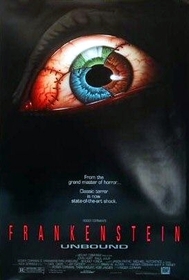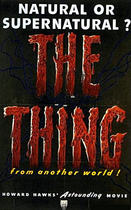Our editor-in-chief Nate Yapp is proud to have contributed to the new book Hidden Horror: A Celebration of 101 Underrated and Overlooked Fright Flicks, edited by Aaron Christensen. Another contributors include Anthony Timpone, B.J. Colangelo, Dave Alexander, Classic-Horror.com's own Robert C. Ring and John W. Bowen. Pick up a copy today from Amazon.com!
Frankenstein Unbound (1990)
What if Mary Shelley was not a novelist, but an historian? What if Victor Frankenstein was a real person and not merely a character? What if a 21st Century scientist created a monster worse than Frankenstein? These questions are addressed in Roger Corman’s 1990 film, Frankenstein Unbound, an adaptation of noted sci-fi author Brian Aldiss’s novel of the same name. The film marks horror legend Corman’s return to the director’s chair after a nearly twenty year absence, but unfortunately, this is not a triumphant return, but a film with a reach that far exceeds its grasp. It grapples with some profound and disturbing themes, but it does so in a silly and unconvincing manner. Despite some solid moments and a few strong performances, Frankenstein Unbound is ultimately unsatisfying.
Dr. Joe Buchanan (John Hurt) is a 21st Century scientist who is trying to create a perfect weapon. His experiments lead to a side-effect of time shifts that appear in the form of menacing clouds. One afternoon, Buchanan is caught up in one of these clouds, and he and his super-intelligent car are transported back in time to 19th Century Switzerland. There, he discovers that Victor Frankenstein (Raul Julia) and his creature were not fictional characters, but real people about whom the young Mary Shelley (Bridget Fonda) wrote. Soon, however, Buchanan and the creature are transported ahead in time to the decaying remains of a post-nuclear war earth. Buchanan must now face not only Frankenstein’s monster, but also an even greater monster of his own creation: the destruction of humanity.
Even though the film is an overall disappointment, it does have several positive aspects. The script is a clever re-examination of Mary Shelley’s novel, and it is a thoughtful commentary on the responsibility creators have to their progeny. It incorporates several details of the novel Frankenstein into the film, and it provides a wonderful portrait of the creature. He can speak, and he questions his own existence in an almost childlike manner. He is not as intelligent as in Shelley’s novel, and he allows himself at one point to be used as Dr. Frankenstein’s thug, but his constant questioning of “who made you?” to many characters is very poignantly written.
Additionally, Nick Brimble (aided by some well imagined, if not so well executed, makeup) offers a sensitive portrayal of the monster. He can be very terrifying, ripping Elizabeth’s chest open at one point, but at the same time he can seem very, as he says, “alone and miserable.” He moves very unsteadily, almost like a toddler who is just learning how to walk. He also speaks in a plaintive, mournful voice that always suggests sadness and a desire to be accepted.
Raul Julia also delivers a strong performance as Dr. Frankenstein. While he seems a bit old to be playing a Swiss medical student, he invests the role with a serious intensity and arrogance that is completely believable. When, near the end, he shouts “I am a scientist, I cannot sin!” he convinces us that he believes completely what he is saying. Like many screen Frankensteins before and after, Julia portrays the good doctor as a man whose obsession makes him completely oblivious to consequences, but who maintains an honest curiosity about science and the world.
Sadly, the rest of the cast is not as strong as Brimble and Julia. Bridget Fonda is not terribly convincing as Mary Shelley; she doesn’t even attempt an English accent. INXS singer Michael Hutchence is flat as Percy Shelley, and even though Jason Patric offers a good interpretation of Lord Byron, his appearance is all too brief. Also flat is Catherine Rabett as Elizabeth, Frankenstein’s love interest. She is rarely seen, and in the brief appearances that she does make, she does little more than say her lines and look pretty. We have to take it on faith that she and Victor are passionately in love, because there is little evidence of this in Rabbett’s performance.
Surprisingly, the most disappointing performance in the film comes from John Hurt. He is certainly energetic, but his interpretation does not seem appropriate for his character. Buchanan is a man who, through his own irresponsibility, is hurtled back through time, makes the astounding discovery that Victor Frankenstein and his creature were real, and gets to sleep with a legend of English literature. One would imagine such a person to react with horror, awe, humility, or many other related feelings. Hurt, however, plays Buchanan with the bemused smirk of a person walking through a well done amusement park. Up until the end of the film, he seems very jolly and not very upset with suddenly finding himself in the early 19th Century. He also somehow possesses sizeable savoir-faire with the world of the past. Near the end of the film, he seems upset and humbled, yet even then he doesn’t seem terribly upset with the destruction of the world. The way Hurt plays him, Buchanan almost seems like an audience member watching the film rather than the film’s key character. This inappropriate performance significantly lowers the emotional power of the film.
Another problem in Frankenstein Unbound is that the script is hazy on what exactly is “unbound.” After Buchanan has killed the monster with an unconvincing laser light show, he wanders out into the devastated world of the future. We hear the late monster’s voice saying he cannot be killed, that he is unbound. Presumably, this means that once evil is released into the world, it cannot be put back. However, this is not made clear and, as it is presented, the “unbound” concept is somewhat confusing. It weakens the horrific nature of the film.
Roger Corman’s direction in this film is competent, but there is nothing terribly special about it. He includes some blurry dream sequences that try to tell Buchanan the nature of the evil he has wrought, but they seem more silly than profound. Additionally, his handling of the 19th Century scenes doesn’t effectively recreate the time and place. Despite the Swiss setting, all of the characters speak not only English, but, inexplicably, English with an American accent. There is very little attention paid to historical detail. This sloppiness greatly diminishes any wonder the audience should have in seeing Buchanan meet many notable historical and fictional characters. Overall, it seems more like a cheap TV-movie effort than the return of a genre icon.
Corman handles the horror elements of the film in a somewhat better fashion. The Creature’s pursuit and murder of Elizabeth is especially well portrayed. No matter how fast Elizabeth moves her carriage, the Creature is faster, and, with an unsettling glee, the Creature rips her chest open. The most chilling moment of this scene comes after Buchanan and Frankenstein find Elizabeth’s body, and Frankenstein muses aloud about the improvements he has made to human abilities in the Creature. Scenes such as this and the sequence when Frankenstein attempts to revive the dead Elizabeth (an idea also used in 1994’s Mary Shelley’s Frankenstein) are the best scenes in the film, and Corman directs them with flair.
Some weak effects and makeup hamper Corman’s direction. The makeup for the Creature (and later Elizabeth) is very well designed, with metal plates protruding out of the Creature’s head. However, it isn’t done very well. It looks too much like just a great deal of makeup and is not very believable. The effects in the film are also disappointing. They look dated even by 1990s standards, and images such as the menacing clouds appear almost cartoon-like. Overall, the entire film feels cheap; even the beautiful Italian scenery cannot make up for the low production values.
Frankenstein Unbound is a great idea for a film that is, sadly, not executed well. Most of the cast is solid, and much of the script is worthwhile, but the lead character is poorly portrayed, and the script is too confusing to be satisfying. Corman directs the film in a capable fashion, but the film is not impressive. It is sad that Corman’s return to the director’s chair could not be stronger.
This review is part of Roger Corman Week, the first of four celebrations of master horror directors done for our Shocktober 2007 event.








